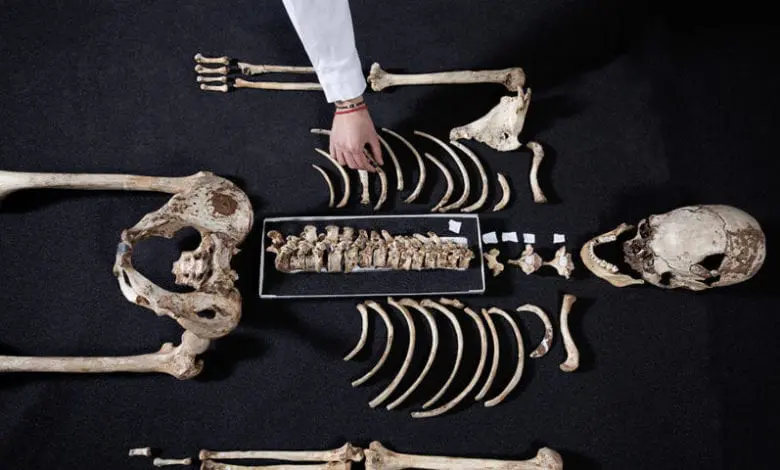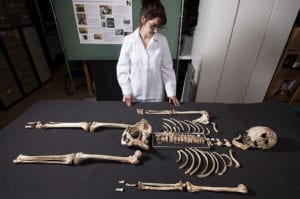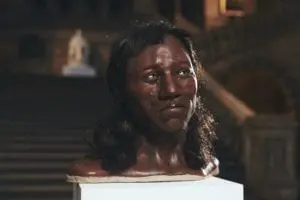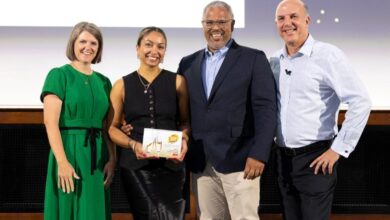The face of the ‘Cheddar Man’

Register to get 1 free article
Reveal the article below by registering for our email newsletter.
Want unlimited access? View Plans
Already have an account? Sign in
A Channel 4 documentary, First Brit: Secrets of the 10,000 Year Old Man, has followed pioneering research carried out by a crack-team of Natural History Museum Human Evolution and DNA specialists, University College London scientists and the world’s foremost prehistoric model makers, to reveal – with unprecedented accuracy – the striking and surprising face of ‘Cheddar Man’, Britain’s oldest nearly complete skeleton.
In one of its most challenging human DNA projects to date – no British individual this old has ever had their genome sequenced – the Natural History Museum’s ancient DNA professor Ian Barnes and his colleague Dr Selina Brace have carried out the first ever full DNA analysis of Cheddar Man. This is only possible because of spectacular breakthroughs in DNA sequencing. Their results will transform both the way we visualise our 10,000 year old ancestors and our understanding of how we relate to them.
Revealing the Face of Cheddar Man
Prof Mark Thomas and Dr Yoan Diekmann at University College London analysed the sequences generated at the Natural History Museum to establish what Cheddar Man looked like. It was previously assumed that Europeans developed paler skin many thousands of years before Cheddar Man, so he was thought to have had reduced skin pigmentation and fair hair. The results however, indicate that whilst Cheddar Man had blue eyes, he also had dark coloured curly hair and ‘dark to black’ skin pigmentation. This means that the lighter pigmentation now considered to be a defining feature of northern Europe, is a far more recent phenomenon.
Cheddar Man’s European and British profile – and Middle Eastern Origins
Cheddar Man’s genetic profile places him with several other Mesolithic-era Europeans whose DNA has already been analysed – individuals from Spain, Hungary and Luxembourg. These so-called ‘western hunter-gatherer’s’, a group that includes Cheddar Man’s ancestors, migrated into Europe at the end of the last ice age. Today, around 10 percent of White British ancestry can be linked to that population.
The History of ‘Cheddar Man’
A human male fossil skeleton, unearthed in 1903 in Gough’s Cave at Cheddar Gorge, Somerset, Cheddar Man has been the topic of constant mystery and intrigue. For over 100 years, scientists have tried to reveal Cheddar Man’s story, posing theories as to what he looked like, where he came from and what he can tell us about our earliest ancestors. Only now with world-leading research, cutting-edge DNA and facial reconstruction can we see for the first time the face of this 10,000 year old man, and ask how 300 generations later he relates to us today.
How the Face was Created
Working in the Natural History Museum’s ancient DNA lab, Prof Barnes and Dr Brace drilled a tiny hole, 2mm in diameter, into the ancient skull, allowing them to obtain a few milligrams of his bone powder for analysis. As the DNA was unusually well-preserved, possibly due to the cool, stable conditions in the limestone cave, they were able to extract sufficient genetic information that could usefully inform the facial reconstruction.
To allow the model makers, Dutch identical twins, Adrie and Alfons Kennis to reconstruct Cheddar Man’s face using 3D printing, the Natural History Museum team also employed the use of a hi-tech scanner, originally designed for use on the International Space Station, to render his skull in full three-dimensional detail. The brothers have created scores of reconstructions for the world’s top museums and were able to flesh out the skull based on the 3D scans from the Natural History Museum to create facial features based on the results of the scientific research.
 Cannibals in Gough’s Cave
Cannibals in Gough’s Cave
Dr Silvia Bello, along with the Natural History Museum’s Prof Chris Stringer, has spent the last ten years analysing the bones of the earlier inhabitants of the cave which date back nearly 5000 years before Cheddar Man. They have established that these early humans were cannibals. These temporary visitors came during an ice–age thaw, but were driven out – like all previous humans in Britain – when temperatures dropped again. Prof Stringer and Dr Bello have identified the remains of six individuals: three adults, two adolescents and a young child, aged approximately 3 years old – have all sustained human butchery or chewing damage. They have studied cups made from human skulls which suggest this cannibalistic behaviour was driven by a type of ritual rather than starvation. The DNA profile of Cheddar Man has revealed that although they were found in the very same cave, he shares no direct ancestry with these earlier cannibals.
The Expert
Prof Chris Stringer, research leader in human origins at the Natural History Museum, first excavated at Gough’s Cave 30 years ago. He has been involved in studying material from the site ever since. He said: “I first studied ‘Cheddar Man’ more than 40 years ago, but could never have believed that we would one day have his whole genome – the oldest British one to date! To go beyond what the bones tell us and get a scientifically-based picture of what he actually looked like is a remarkable (and from the results quite surprising!) achievement.”
Prof Ian Barnes, research leader in ancient DNA at the Natural History Museum, led a team of ancient DNA experts as they analysed the entire DNA of the fossil skeleton. He said: “Cheddar Man is one of the oldest human specimens that we’ve worked with, and yet the preservation of DNA has been good enough to recover huge amounts of information about his appearance and ancestry. It’s been fantastic working with this excellent team, and getting to sample one of the most important human skeletons in the museum collection.”
Channel 4’s commissioning editor Rob Coldstream says, “Channel 4 is delighted to have been able to follow the incredible research of this extraordinary project. It is very exciting to think that we will be able to share these results and enable the rest of the UK to see what the first ‘Brit’ really looked like.”
First Brit: Secrets of the 10,000 Year Old Man aired on Channel 4 and is available on 4oD


 Cannibals in Gough’s Cave
Cannibals in Gough’s Cave




